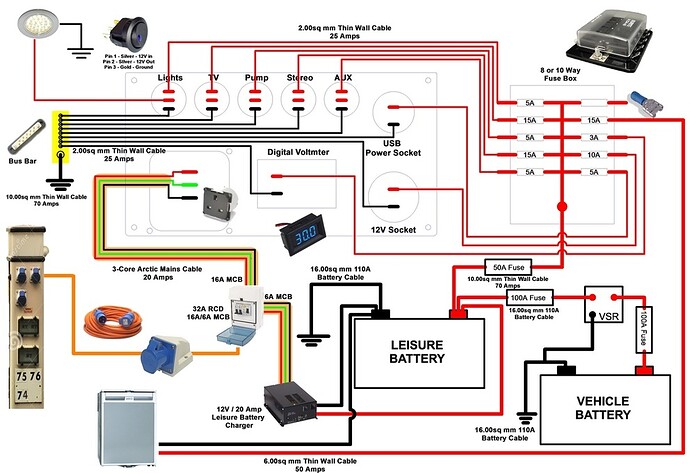Hi @djpriddle and welcome!
What you have described so far are just a few of the basics you will need. I would add that some of the most important devices on any electrical system (especially on low voltage DC systems) are the protection and isolation devices. You should also consider at least having a protection device installed in the van for the 240V AC as it adds one more layer of protection if you are plugged in, but for it to work, make sure the earthing has been correctly done.
As far as your inverter goes, don’t just buy the biggest and most powerful just because it is. Instead, work out your total maximum load potential and with a general rule of thumb, buy an inverter with “twice” the capacity. (ie maximum load potential is 500w, you will normally only need at the very most, a 1000w inverter)
Most inverters will use some amount of standby current when switched on which will result in eventual discharge of your leisure battery if you aren’t able to charge it for any reason.
That said, you could consider and inverter/charger all-in-one set up which will charge the battery while plugged in. Some inverter/charger units, when plugged in, will also run the van 240V AC system on bypass, giving the batteries a rest.
On a side note but still relevant…
To give an idea of the potential loading on your battery while running for example, a 160w slow cooker, and including the operating current while the inverter is switched on, my battery monitor shows a current draw of around 11-12 amps. So running this for around four hours (average time it takes to cook one of my meals) will take up to 50 amps from the battery. This is why I am either plugged in or charging from my alternator when I use the slow cooker.
A note on charging from the alternator, you will only be able to use a split charge relay on a van fitted with an old style non-smart alternator. However, if your van is fitted with a smart alternator as most are these days, you will need a DC to DC charger to charge the leisure battery.
As far as wiring goes…
For the 12V DC system it is important to consider the maximum current that will be passing through the wires and buy the correct size of wire. The term SWG is normally used to measure wire size. Incidentally, it is not only the minimum safe size of wire you should consider, but also the minimum size at which the current can be efficiently carried along the wire. This means it would be a good idea to increase your wire size from the recommended minimum to the next size up at the very least.
From what you describe of the 240V AC system, this is a standard basic caravan setup which in most cases would only require a three core wire with a cross sectional area of somewhere between 1.5 mm and 2mm squared.
So you can keep an eye on the system’s performance, it is also advisable to include a simple battery monitor.
I’ll leave it at that for now so you can go and do some research on what might be best for you…
I hope this helps.
